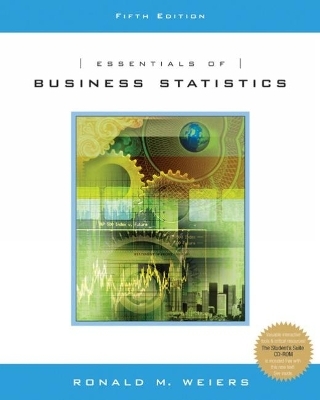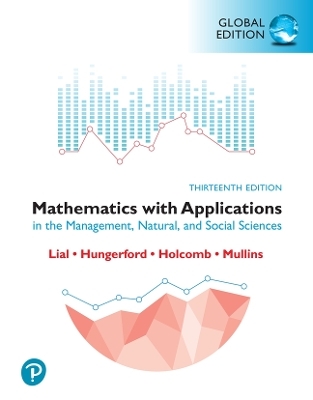
Essentials of Business Statistics
South-Western
978-0-534-46485-1 (ISBN)
- Titel erscheint in neuer Auflage
- Artikel merken
ESSENTIALS OF BUSINESS STATISTICS is a select subset of the core chapters from the renowned INTRODUCTION TO BUSINESS STATISTICS. Highly praised for its clarity and great examples, Ronald Weiers' text takes an informal, student-oriented approach to presenting fundamental statistical concepts. Non-technical terminology and outstanding illustrations explain statistical concepts in the context of contemporary applications. Weiers puts business students at ease with the material by providing numerous learning aids and interesting applications drawn from students' real-world experience.
Part I: BUSINESS STATISTICS: INTRODUCTION AND BACKGROUND.
1. A Preview of Business Statistics.
Introduction. Statistics: Yesterday and Today. Descriptive versus Inferential Statistics. Types of Variables and Scales of Measurement. Statistics and Business Decisions. Business Statistics: Tools versus Tricks. Summary.
2. Visual Description of Data.
Introduction. The Data Array and the Frequency Distribution. The Stem-and-Leaf Display and the Dotplot. Visual Representation of the Data. The Scatter Diagram. Tabulation, Contingency Tables, and the Excel PivotTable Wizard. Summary.
3. Statistical Description of Data.
Introduction. Statistical Description: Measures of Central Tendency. Statistical Description: Measures of Dispersion. Additional Dispersion. Descriptive Statistics from Grouped Data. Statistical Measures of Association. Summary.
4. Data Collection and Sampling Methods.
Introduction. Research Basics. Survey Research. Experimentation and Observational Research. Secondary Data. The Basics of Sampling. Sampling Methods. Summary.
Part II: PROBABILITY.
5. Probability: Review of Basic Concepts.
Introduction. Probability: Terms and Approaches. Unions and Intersections of Events. Addition Rules for Probability. Multiplication Rules for Probability. Bayes' Theorem and the Revision of Probabilities. Counting: Permutations and Combinations. Summary.
6. Discrete Probability Distributions.
Introduction. The Binomial Distribution. The Poisson Distribution. Simulating Observations from a Discrete Probability Distribution. Hypergeometric Distribution (Optional CD Topic). Summary.
7. Continuous Probability Distributions.
Introduction. The Normal Distribution. The Standard Normal Distribution. The Normal Approximation to the Binomial Distribution. The Exponential Distribution. Simulating Observations from a Continuous Probability Distribution. Summary.
Part III: SAMPLING DISTRIBUTIONS AND ESTIMATION.
8. Sampling Distributions.
Introduction. A Preview of Sampling Distributions. The Sampling Distribution of the Mean. The Sampling Distribution of the Proportion. Sampling Distributions When the Population is Finite. Computer Simulation of Sampling Distributions. Summary.
9. Estimation From Sample Data.
Introduction. Point Estimates. A Preview of Interval Estimates. Confidence Interval Estimates for the Mean: Sigma; Known. Confidence Interval Estimates for the Mean: Sigma; Unknown. Confidence Interval Estimates for the Population Proportion. Sample Size Determination. When the Population Is Finite. Summary.
Part IV: HYPOTHESIS TESTING.
10. Hypothesis Tests Involving a Sample Mean or Proportion.
Introduction. Hypothesis Testing: Basic Procedures. Testing a Mean, Population Standard Deviation Known. Confidence Intervals and Hypothesis Testing. Testing a Mean, Population Standard Deviation Unknown. Testing a Proportion. The Power of Hypothesis Test. Summary.
11. Hypothesis Tests Involving Two Sample Means or Proportions.
Introduction. The Pooled Variances t-test for Comparing the Means of Two Independent Samples. The Unequal-Variances t-Test for Comparing the Means of Two Independent Samples. The z-Test for Comparing the Means of Two Independent Samples. Comparing Two Means when the Samples are Dependent. Comparing Two Sample Proportions. Comparing the Variances of Two Independent Samples. Summary.
12. Analysis of Variance Tests.
Introduction. Analysis of Variance: Basic Concepts. One-Way Analysis of Variance. The Randomized Block Design. Two-Way Analysis of Variance. Summary.
13. Chi-Square Applications.
Introduction. Basic Concepts in Chi-Square Testing. Tests for Goodness of Fit and Normality. Testing the Independence of Two Variables. Comparing Proportions from k Independent Samples. Estimation and Tests Regarding the Population Variance. Summary.
14. Nonparametric Methods.
Introduction. Wilcoxon Signed Rank Test for One Sample. Wilcoxon Signed Rank Test for Comparing Paired Samples. Wilcoxon Rank Sum Test for Comparing Two Independent Samples. Friedman Test for the Randomized Block Design. Other Nonparametric Methods. Summary.
Part V: REGRESSION, MODEL BUILDING, AND TIME SERIES.
15. Simple Linear Regressions and Correlation.
Introduction. The Simple Linear Regression Model. Interval Estimation Using the Sample Regression Line. Correlation Analysis. Estimation and Tests Regarding the Sample Regression Line. Additional Topics in Regression and Correlation Analysis. Summary.
16. Multiple Regression and Correlation.
Introduction. The Multiple Regression Model. Interval Estimation in Multiple Regression. Multiple Correlation Analysis. Significance Tests in Multiple Regression and Correlation. Overview of the Computer Analysis and Interpretation. Additional Topics in Multiple Regression and Correlation. Summary.
Optional Chapter on Accompanying CD-ROM: Ethics in Statistical Analysis and Reporting.
Appendix A: Statistical Tables.
Appendix B: Selected Answers.
Index/Glossary.
| Erscheint lt. Verlag | 2.2.2005 |
|---|---|
| Verlagsort | Mason, OH |
| Sprache | englisch |
| Maße | 211 x 251 mm |
| Gewicht | 1589 g |
| Themenwelt | Mathematik / Informatik ► Mathematik ► Finanz- / Wirtschaftsmathematik |
| Mathematik / Informatik ► Mathematik ► Statistik | |
| ISBN-10 | 0-534-46485-8 / 0534464858 |
| ISBN-13 | 978-0-534-46485-1 / 9780534464851 |
| Zustand | Neuware |
| Haben Sie eine Frage zum Produkt? |
aus dem Bereich



